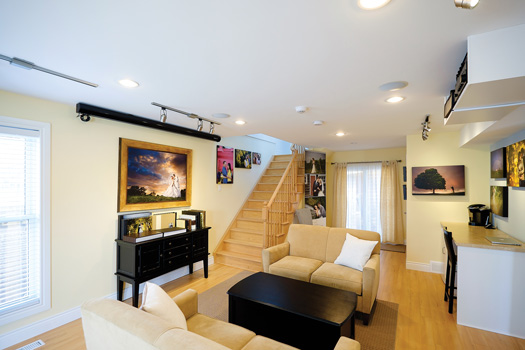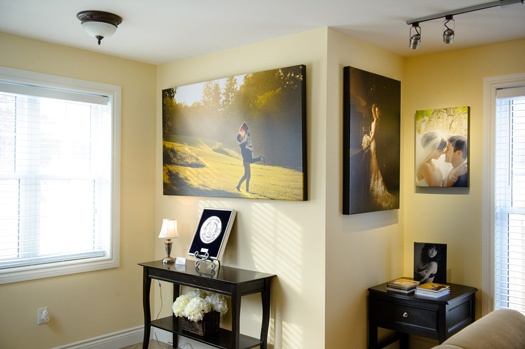Seal the Deal: Catering to a Potential Client’s Five Senses
September 15, 2014
There is much that can be learned by studying the successes of other businesses outside of our photographic industry. For instance, look at the dining experience at New York City’s Le Bernardin versus McDonalds, or the buying experience at BMW versus Ford. The first company in each comparison may indeed offer a better product or service, but it’s the refined experience that helps to justify their higher price point and increases brand loyalty.
As photographers, we want to create a sales environment that pleases our clients’ sight, smell, sound, taste and touch not only to make clients feel comfortable, but also to create an experience for which they’ll return (and tell friends). What follows are specific ways that you can properly “set the scene” to increase business.

Your clients will notice everything about your space, and make mental notes. Be obsessive about appealing to each of the five senses. All photos © Bryan Caporicci
TOUCH
Walk through your studio as a “new client” coming in for the first time, and observe every single physical element you come in contact with. From the moment your client walks into your studio, every physical tactile interaction will be noted, and as such, every touch point is a reflection of you. The doorknob they turn, the feel of the flooring under their feet, the temperature of the room, the handshake that you greet them with, the furniture they sit on, the glass they drink from and the albums they flip through all will affect their impression.
Be sure that each touchpoint leaves a consistent impression that is aligned with the brand you’re trying to project. Make sure that your dish wear (mugs, cups, glasses) is representative of your brand. If you are going after a higher-end clientele, for example, then invest in quality pieces from a higher-end housewares store. When ordering sample albums for your studio, choose the finest materials, show off large books and a variety of sizes.
SIGHT
The visual experience that our clients have with us in our studio is paramount. Some things to keep in mind: The visual flow or “visual path” clients take when they enter the studio, as well as where their eyes are left to wander and what they settle on as they are sitting with you during the meeting, is important. Be intentional about directing their vision to the right places, the right images, the right products and the right brand re-enforcers.
The decor in your studio, including the color of your walls, furniture, flooring, lighting, flowers, plants, and any other supplemental decor or visuals that add to the warmth of your studio, matters, too. The wall portraits that you have displayed need to attract attention in the right way. Not only does proper sizing, grouping and placement have to be considered, but also the right presentation—lighting, level, placement, height, etc.
Consider the products that you have on display, which may include gift prints, books, albums, bags, totes and cards. Take care in how and where they’re displayed, and how they’re arranged.

Everything you display in your studio or home office has significance, so make sure photos, groupings and placement are all appealing.
Align everything your client sees with the brand you wish to portray. The quality of your photography is an obvious visual cue to your clients of the quality they can expect from you. Show only your best work, but also be deliberate in showing images that are unique to you and your style, as well as photographs that you can attach a story to when conversing with your clients.
Your personal physical appearance is a big part of their perception of you, the quality of your work and your professionalism. Dress appropriately, be properly groomed and be physically welcoming and warm with your body language during your meeting.
SMELL
If you’ve been to an Abercrombie & Fitch store as an adult, then you can probably attest to the fact that sense of smell can have a big impact on the experience with a brand. The nausea-inducing, overbearing smell of teenage cologne (intentionally sprayed throughout the store) overwhelms your nostrils and probably repels you, but that’s OK to the company because you aren’t its target customer; the teens who shop there, however, love it because it connects with them on a subconscious level.
For a professional photography studio, my first suggestion would be to eliminate negative smells—keep garbages empty, bathrooms clean, carpets vacuumed and floors mopped. The next step is infusing soft, subtle and warming aromas via a candle. I have found that the best scents are ones that represent “home” or more specifically, something that represents some kind of baked good. I’d recommend vanilla, cinnamon, ginger, coconut or pumpkin spice. Remember: the scent shouldn’t be overwhelming, but rather should be subtle and complementing—one candle per room should be enough.
SOUND
Dead silence between sides of a conversation can be awkward and displeasing. You can create a welcoming environment by having soft music playing throughout your studio to fill those conversational voids. I’d suggest checking out some of the iTunes radio channels under Classical, Jazz or Ambient. Spotify and Songza also have great mood playlists to choose from. Beware: the only thing more awkward than dead silence between conversation is an inappropriate commercial that comes on just at the wrong time. You’ll eventually want to find a free service that you like, and then purchase or subscribe to the paid, radio-free version.
I’d additionally suggest doing what you can to spread the music throughout your studio so as to not have it localized to a computer speaker in a corner of the room. Look into wireless speakers for a clean well-distributed musical influence.
Lastly, as it relates to sound, be sure to have additional third-party sounds minimized as much as possible. If you have a home studio, don’t have kids running around, vacuums running, grass being cut, etc. Make your family aware of your meeting schedule and let them know what can and can’t be done during those times.
TASTE
I certainly wouldn’t suggest cooking your clients a full dinner for your meeting with them, but I do believe that there are ways to positively affect their taste buds. Offer refreshments (water, soda, coffee, tea) and small supplemental sweets (chocolates, biscuits, etc.). A full snack (fruit, chips, bread, cookies) normally doesn’t go over too well with new clients, but if it’s something that’s in addition to the drink you’re serving, then it is usually well received (a nice, hot cup of coffee with an individually wrapped Lindor chocolate on the side will make a nice impression and doesn’t require your client to use a fork and knife to consume).
Think about the brand of refreshment that you offer. For example, if you are hoping to go after the “high-end market,” serve premium refreshments such as San Pellegrino and Fiji water. In addition, have a few different choices for coffee and tea as well as a decaffeinated option.
Pre-Meeting Checklist
It’s ideal to host meetings in your “home base” where you can control the environment. Before every meeting, set aside 30 minutes to walk through your studio as if you were a new client. Use this checklist as a starting point, and add on to it as needed or as is specific to your studio:
✓ Are all of the lightbulbs working and turned on?
✓ Do the prints line up properly?
✓ Is there dust anywhere? Check books/albums, the tops of prints and canvases.
✓ Line all of your albums up to be square to each other and properly displayed.
✓ Fluff the cushions and pillows. If you have a micro-fiber couch or any fabric that shows grain, pat it all down in the same direction so that it looks neat.
✓ Keep the temperature consistent—cool in the summer, warm in the winter.
✓ Light a candle 15 minutes before the meeting.
✓ Be sure that your background music is playing softly.
✓ Clean and tidy up the bathroom—make sure soap is full, toilet paper is rolled up and folded, the seat is down and a hand towel is clean and folded nicely.
✓ De-clutter your studio, hide wires and put away any non-essentials.
✓ Vacuum carpets and sweep any hardwood or tile.
✓ Turn your portfolio slideshow on your TV, computer screen or anywhere else that you want it displayed.
✓ Make sure plants and flowers are watered, trimmed, dead-headed and looking good.
✓ Make sure your personal hygiene is in order, your hair is neat and your wardrobe is appropriate.
✓ Turn you coffee machine on. Brew a cup for yourself so that the aroma of coffee is in the air.
✓ Make sure that your fridge is fully stocked with water and soda.
Bryan Caporicci is an author, speaker, educator and award-winning wedding and portrait photographer based in Fonthill, Canada. He is the founder of SproutingPhotographer.com, where he writes “how-to” articles for photographers on the business of being creative. He also hosts the Sprouting Photographer podcast (available on iTunes), where he interviews industry leaders and business experts about business topics as they relate to photography.
Related Links:
Branding with Blair: How to Set Yourself Apart with Strong Marketing Strategies
Take Control of Your Business: 10 Studio Management Software Programs
Setting the Price: How to Charge for Photography Services




